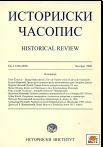Смедеревска варош од 1459. године до краја 16. века
The varoş of Smederevo from 1459 till the End of the 16th Century
Author(s): Bojan Popović, Srđan KatićSubject(s): History
Published by: Istorijski institut, Beograd
Keywords: Smederevo; varoş; çarşı; mahalle; zaviye; mescid; mosque; vakf
Summary/Abstract: Smederevo was the most important military stronghold in the European part of the Ottoman Empire since the Ottoman conquest in 1459 till the 1520s and it kept its military and economic importance during next couple of decades. Smederevo was manned by 1,700 soldiers in the second half of the 15 th century and in the first half of the 16 th century, while the number of civilians was four times less. Two thirds of the crew were Muslims and one third were Christians. Only after the conquest of Banat in 1552 and Gyula in 1566, the crew was significantly reduced, so the census from 1572 showed 457 soldiers, of which 113 were Christians. During the first fifty years of Ottoman rule, besides the Muslim soldiers, the fortress was home to the majority of the Muslim civilians. Obviously they did not feel safe enough outside the fortress, because there were eight mahalles within and only one Muslim mahalleoutside its limits. The Muslim civilians have populated the varoş only by the end of the second decade of the 16 th century. Christian soldiers and civilians lived in the varoş. They were overwhelming majority compared to the Muslims until the middle of the 16th century. The number of Christians was rapidly declining during next couple of decades. Main reasons were mass lay-offs and military transfers within Smederevo garrison, migration to Banat and islamisation. Decline of the number of Christians also was caused by the Long War (1593-1606), after which the varoş had six times less Christians than a century earlier. Smederevo Christians where Serbs by an overwhelming majority. Separate records were kept on the Ragusians and inhabitants with the “vlach” status until the 1530s and Jews from the second half of the century. Second half of the 16 th century is marked by declining of Smederevo and its marginalisation in comparison to Belgrade. This was particularly noticeable during the Long War (1593-1606) and once it was finished, the former capital of the Serbian Despotate and center of the Ottoman province, became village-town (kasaba)without any military or economic importance.
Journal: Историјски часопис
- Issue Year: 2013
- Issue No: 62
- Page Range: 79-115
- Page Count: 37
- Language: Serbian

